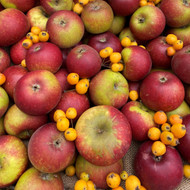In Part One of our guide, we looked at some of the general considerations of choosing apple varieties, along with a few favourite eaters. Time to widen the net and offer up some more suggestions for a wider range of uses and situations. If after reading all of this you are still unsure, don't worry -we're here to help! We've put together a simple form (affectionately nicknamed the Appletron 5000) which contains most of the information we need to guide you on your way. Fill in as much as you can, send it back to us and we will happily point you in the right direction:
Otherwise use the following suggestions as a starting point to guide you on your journey:
If you like Cox’s Orange Pippin: Lord Lambourne, Sunset, Superb
If you like a slightly softer sweeter apple: James Grieve, Fortune, Greensleeves, Ellison’s Orange
If you want an apple to eat fresh from the tree: Epicure, Early Worcester, Irish Peach
If you want an eating apple which stores well: Crispin, Tydeman’s Late Orange, Sturmer Pippin, Colapuy
If you want a cooking apple which falls on cooking: Bramley, Grenadier, Monarch
If you want a cooking apple which keeps it shape: Howgate Wonder, Lord Derby
If you want a good early cooking apple: Arthur Turner, Rev W Wilkes
If you want a disease-resistant dessert variety: Discovery, Ellison’s Orange, or Fiesta
If you want a disease-resistant culinary variety: Early Victoria, Grenadier or Monarch
If you only have space for one tree, consider a dual purpose variety: Blenheim Orange, Charles Ross, Newton Wonder, Keswick Codling
If you want to try something more unusual, go for one of the connoisseur’s apples: Ashmead’s Kernel, Court Pendu Plat, Orleans Reinette, St Edmund’s Pippin, Lady Sudeley
If you want a russeted variety: Brownlee’s Russet, Rosemary Russet
If you want a sweet, mid-season eater: Michaelmas Red, Red Gravenstein
If you want an all-rounder; eater, cooker, cider, striking blossom: Golden Spire, Katy


